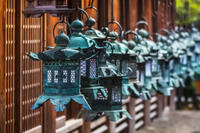Nara Afternoon Tour of Todaiji Temple, Deer Park and Kasuga Shrine from Osaka
Osaka, Japan
Rating: 







Trip Type: Day Trips
Duration: 6 hours 30 minutes
Enjoy an afternoon visit to Nara, whose combined historic monuments make the ancient city a UNESCO World Heritage site. This imperial capital from the 8th century is full of cultural treasures, including some of Japan's oldest Buddhist temples. Ride the JR rail from Osaka to Kyoto, where you’ll transfer by comfortable coach to Nara. After your tour of Todaiji Temple, Deer Park and Kasuga Shrine with a knowledgeable guide, you’ll return to Osaka by train.
More About This Activity All Day Trips →
Enjoy an afternoon visit to Nara, whose combined historic monuments make the ancient city a UNESCO World Heritage site. This imperial capital from the 8th century is full of cultural treasures, including some of Japan's oldest Buddhist temples. Ride the JR rail from Osaka to Kyoto, where you’ll transfer by comfortable coach to Nara. After your tour of Todaiji Temple, Deer Park and Kasuga Shrine with a knowledgeable guide, you’ll return to Osaka by train.Depart Osaka and travel by JR rail to Kyoto, where you'll join your tour of Nara. Board the coach and drive less than 1 hour from Kyoto to explore some of the city’s UNESCO World Heritage sites with your guide.
Japan's first permanent capital was established in the year 710 at Heijo, the city now known as Nara. As the influence and political ambitions of the city's powerful Buddhist monasteries grew to become a serious threat to the government, the capital was moved to Nagaoka in 784.
Visit the 8th-century Todaiji Temple, one of Japan's most famous and historically significant temples. In its huge precincts you’ll find various national treasures of Japan. The Daibutsuden (Great Buddha Hall) is one of the world's largest wooden buildings, which enshrines a gigantic bronze statue of Buddha — a wonder of religious architecture! Exploring the grounds during any season will showcases the most impressive displays of nature, from vivid fall colors to Japanese cherry blossoms in full bloom.
See more than 1,000 tame deer roaming freely in the verdant Deer Park, which comprises 1,250 acres (505 hectares). If you wish to feed the deer, they will gladly eat from your hand. (Special deer food is available for sale in the park grounds.)
Your last stop is Kasuga Shrine, the most famous and beautiful Shinto shrine in Nara. Part of the historic monuments of ancient Nara, it features some 3,000 antique stone and bronze lanterns. Walk along the outdoor pathway as you listen to commentary from your guide about the shrine’s influence on Japanese culture.
Afterward, travel by return rail directly to Osaka Station, where you’ll make your own way back to your hotel.
Japan's first permanent capital was established in the year 710 at Heijo, the city now known as Nara. As the influence and political ambitions of the city's powerful Buddhist monasteries grew to become a serious threat to the government, the capital was moved to Nagaoka in 784.
Visit the 8th-century Todaiji Temple, one of Japan's most famous and historically significant temples. In its huge precincts you’ll find various national treasures of Japan. The Daibutsuden (Great Buddha Hall) is one of the world's largest wooden buildings, which enshrines a gigantic bronze statue of Buddha — a wonder of religious architecture! Exploring the grounds during any season will showcases the most impressive displays of nature, from vivid fall colors to Japanese cherry blossoms in full bloom.
See more than 1,000 tame deer roaming freely in the verdant Deer Park, which comprises 1,250 acres (505 hectares). If you wish to feed the deer, they will gladly eat from your hand. (Special deer food is available for sale in the park grounds.)
Your last stop is Kasuga Shrine, the most famous and beautiful Shinto shrine in Nara. Part of the historic monuments of ancient Nara, it features some 3,000 antique stone and bronze lanterns. Walk along the outdoor pathway as you listen to commentary from your guide about the shrine’s influence on Japanese culture.
Afterward, travel by return rail directly to Osaka Station, where you’ll make your own way back to your hotel.
« Go Back

